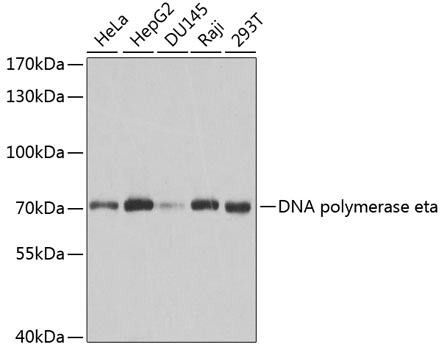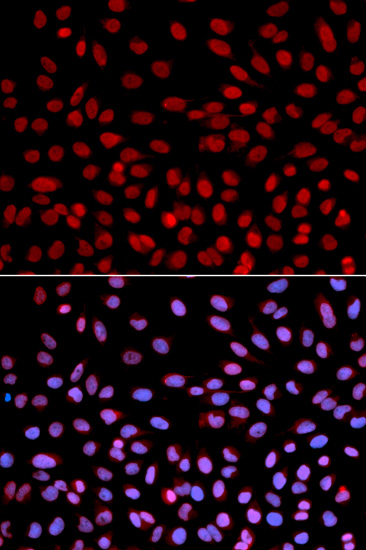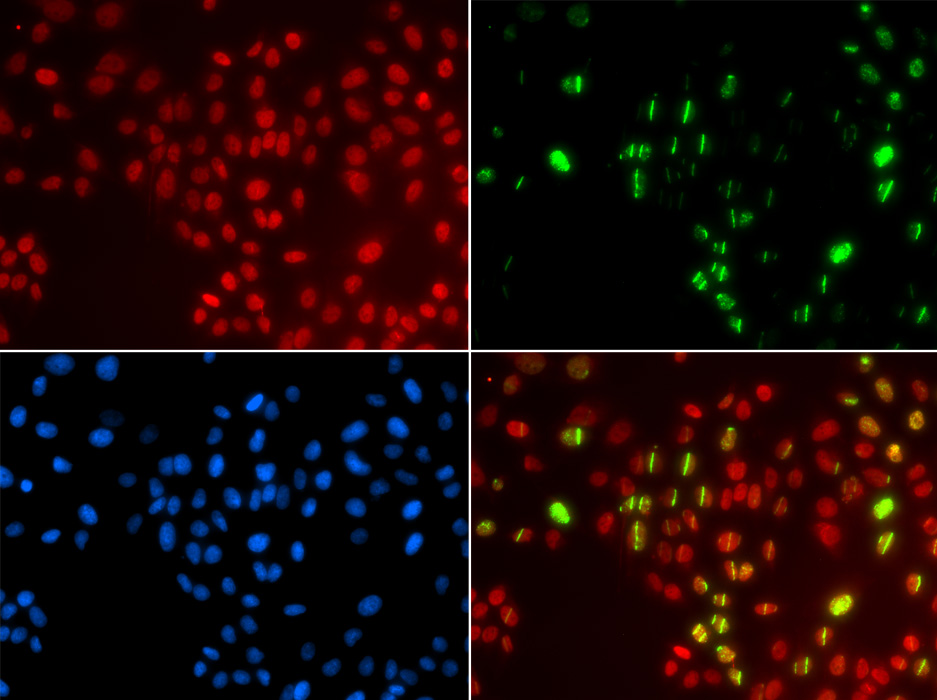-
Product Name
DNA polymerase eta Polyclonal Antibody
- Documents
-
Description
Polyclonal antibody to DNA polymerase eta
-
Tested applications
WB, IF
-
Species reactivity
Human, Mouse, Rat
-
Alternative names
POLH antibody; RAD30 antibody; RAD30A antibody; XP-V antibody; XPV antibody; DNA polymerase eta antibody
-
Isotype
Rabbit IgG
-
Preparation
Antigen: Recombinant fusion protein containing a sequence corresponding to amino acids 20-320 of human DNA polymerase eta (NP_006493.1).
-
Clonality
Polyclonal
-
Formulation
PBS with 0.02% sodium azide, 50% glycerol, pH7.3.
-
Storage instructions
Store at -20℃. Avoid freeze / thaw cycles.
-
Applications
WB 1:500 - 1:2000
IF 1:50 - 1:200 -
Validations

Western blot - DNA polymerase eta Polyclonal Antibody
Western blot analysis of extracts of various cell lines, using DNA polymerase eta antibody at 1:1000 dilution.Secondary antibody: HRP Goat Anti-Rabbit IgG (H+L) at 1:10000 dilution.Lysates/proteins: 25ug per lane.Blocking buffer: 3% nonfat dry milk in TBST.

Immunofluorescence - DNA polymerase eta Polyclonal Antibody
Immunofluorescence analysis of U2OS cells using DNA polymerase eta antibody . Blue: DAPI for nuclear staining.

Immunofluorescence - DNA polymerase eta Polyclonal Antibody
Immunofluorescence analysis of GFP-RNF168 transgenic U2OS cells using DNA polymerase eta antibody . Greenuff1aGFP-RNF168 fusion protein expression for DNA damage marker.Blue: DAPI for nuclear staining.RNF168 can be used to mark cells damaged by UV-A laser for they always gather around DNA damage region.
-
Background
DNA polymerase specifically involved in the DNA repair by translesion synthesis (TLS). Due to low processivity on both damaged and normal DNA, cooperates with the heterotetrameric (REV3L, REV7, POLD2 and POLD3) POLZ complex for complete bypass of DNA lesions. Inserts one or 2 nucleotide(s) opposite the lesion, the primer is further extended by the tetrameric POLZ complex. In the case of 1,2-intrastrand d(GpG)-cisplatin cross-link, inserts dCTP opposite the 3' guanine. Particularly important for the repair of UV-induced pyrimidine dimers. Although inserts the correct base, may cause base transitions and transversions depending upon the context. May play a role in hypermutation at immunoglobulin genes. Forms a Schiff base with 5'-deoxyribose phosphate at abasic sites, but does not have any lyase activity, preventing the release of the 5'-deoxyribose phosphate (5'-dRP) residue. This covalent trapping of the enzyme by the 5'-dRP residue inhibits its DNA synthetic activity during base excision repair, thereby avoiding high incidence of mutagenesis. Targets POLI to replication foci.
Related Products / Services
Please note: All products are "FOR RESEARCH USE ONLY AND ARE NOT INTENDED FOR DIAGNOSTIC OR THERAPEUTIC USE"
